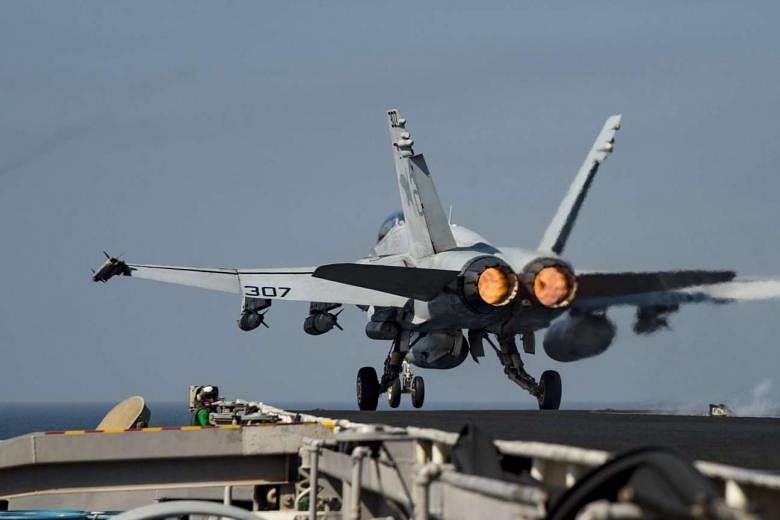KABUL (REUTERS) - American air strikes in Afghanistan this year have already significantly surpassed the total number conducted in 2015, a stark indicator of the United States' struggle to extricate itself from the conflict and stick to its declared "non-combat" mission.
American warplanes have conducted around 700 air strikes so far this year, compared to about 500 in total last year, according to US military officials, signalling a deeper role for American forces that is expected to continue for the foreseeable future.
Ending American involvement in Afghanistan was one of President Barack Obama's signature promises and he declared the combat mission over at the end of 2014.
In the last year of his presidency, however, rising violence has led Mr Obama to keep more US forces in the fight, both to target a growing Islamic State in Iraq and Syria (ISIS) presence and back up struggling Afghan troops.
Top American military commanders in Afghanistan successfully pressed Mr Obama to reverse earlier restrictions on the use of air strikes, clearing the way for a spike in attacks on ISIS and Taleban targets.
"The increase in strikes is due to the additional authorities US forces received and due to the Afghan change in strategy to offensive operations," US military spokesman Brigadier General Charles Cleveland told Reuters in a statement. "The new authorities have allowed the US to be more proactive and deliberate in supporting this year's Afghan offensive operations and in aggressively targeting (ISIS)."
With no end in sight for one of America's longest wars, any decisions on the future of the air strikes and nearly 9,000 US troops that will remain in Afghanistan will be up to the winner of the Nov 8 American presidential election.
"It will be important to ask if the relaxation of rules of engagement that President Obama provided to American/Nato forces in Afghanistan in 2016 should go further, allowing even more substantial use of their air power against the Taleban," wrote a dozen former US military commanders and ambassadors to Afghanistan in an October report outlining challenges for the next president.
Of the approximately 700 air strikes that occurred between January 1 and October 20, about 240 were under rules approved by Mr Obama in June that allowed US forces to more actively support Afghan troops during strategic combat operations, Brig Gen Cleveland said.
A similar number were conducted against "counter-terrorism"targets, including about 50 against Al-Qaeda and 190 against ISIS, he said.
Other air strikes can be conducted in defence of US and international military advisors, as well as some Afghan troops.
American air strikes have been credited with helping to prevent Taleban forces from completely overrunning cities like Lashkar Gah, the capital of embattled Helmand province, but militants still contest or control as much as a third of the country.
"Washington's military planners originally expected Afghan troops to be able to hold their own more than a decade after the United States' initial invasion," the private intelligence firm Stratfor concluded in a recent report. "But with instability still plaguing Afghanistan's north, south and east, they are as dependent on foreign air power and aid as they were when Operation Enduring Freedom began."
The nascent Afghan air force has also nearly doubled its air strikes, US officials said, but has yet to fully take over the air war against Taleban and other insurgents.
"(US) air strikes are very important and we need them for a longer time to tackle our enemies," Afghan Ministry of Defence spokesman Dawlat Waziri said.
In Afghanistan, the US Air Force maintains a single squadron of F-16 fighter bombers, a unit of armed unmanned aircraft, and a handful of special operations AC-130 gunships. The US Army also deploys its own Apache attack helicopters, and have been observed supporting Afghan troops in places like Kunduz.
For the first time since 2006, massive B-52 bombers operating out of Qatar flew at least two missions in Afghanistan over the summer when they were used to bomb ISIS targets in preparation for a ground assault by Afghan troops in Nangarhar.
Now the air force says it may use any number of the more than 750 aircraft deployed around the region to strike targets in Afghanistan.
"Coalition air power degrades the enemies capability, denies their sanctuary and eliminates their ability to take or hold territory," said air force spokeswoman Kiley Dougherty.
While "counter-terrorism" strikes and protection for coalition forces remain the "bread and butter" for American fighter pilots, the new operations have "changed dynamic quite a bit" as US missions more closely align to Afghan troop movements, said F-16 pilot Rider, who spoke at on condition of being identified only by his call sign.
Besides the changes in targets that American warplanes are allowed to attack, the US military now has a "more mature"relationship with the Afghans that allows air strikes to be called in more effectively in support of the government troops, Rider said in a recent interview at Bagram airfield.

